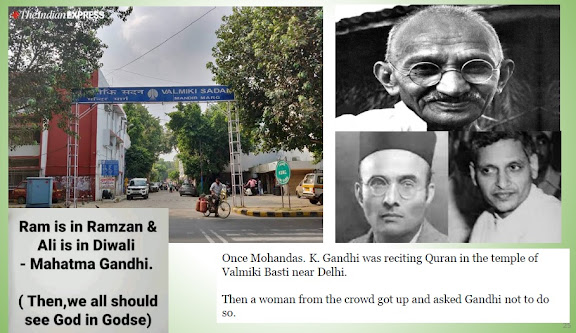Isa Upanishad - Chapter 3: Isa Upanishad
The characteristics of Soul are being described in stanzas 4 to 8. Hence it would be advisable to deal these four stanzas together.
One will be bewildered on reading the most contradictory statements being stated in these stanzas.
The soul, it declares, unmoving, but, moves faster than the mind. It is one, but, it is manifold. Remaining stationary, it outruns all other runners and it ran ahead. It is very near and it is far off. It is inside all and it is outside all as well.
How can we reconcile such contradictory statements? On the face of it, one can simply view them as the statements of a mad man.
Let us take the case of a man traveling in a train from Madurai to Madras. Actually the man had not moved himself, but, he was simply sitting or sleeping in the train. The train took him from Madurai to Madras. Without himself moving, the man could move a long distance and had reached the destined place. How is it possible? Simple. The locomotive power in the form of a train could make this possible. The locomotive power is engineered by a Supreme Power which, if you wish, can name it as God.
Air in the atmosphere is limitless. But the same Air in the balloon is conditioned and is confined to the balloon. When one pricks the balloon with a pin, then the balloon bursts and the air inside mingles with the limitless air in the atmosphere. When the air is blown inside the balloon, the same air loses its power of limitlessness mainly due to ‘ensouled’ position of the air within the confine of the blown rubber in the form of a balloon.
Similarly, the limitless soul, when confined to a body, becomes a limiting factor, though soul is the part and parcel of the limitless Supreme Soul.
Isa Upanishad further describes the self or soul which gives us more inside meanings vividly.
If anyone sees the same self in all beings, then it is the realization of the Supreme Truth. That realization means no hatred towards any one. The world for such realized souls will be full of harmony and peace. Such a person is seer of oneness, as he treats all as equals without any discrimination whatsoever. For such seer, there is neither delusion nor sorrow. All are bliss for him.
As a consolidation of various aspects of the Soul, the Isa Upanishad describes the soul in the 8th stanza as under:
Soul is all pervasive, pure, bodiless, without wound, without sinews, taintless, untouched by sin, omniscient, ruler of mind, transcendent, and self-existent. Soul has duly allotted the respective duties to the eternal years.
Soul is a mystic object and hence it creates confusion and contradiction, when one tries to describe with the tool of a language. It is beyond description and one needs to contemplate and realize the soul.
One will be bewildered on reading the most contradictory statements being stated in these stanzas.
The soul, it declares, unmoving, but, moves faster than the mind. It is one, but, it is manifold. Remaining stationary, it outruns all other runners and it ran ahead. It is very near and it is far off. It is inside all and it is outside all as well.
How can we reconcile such contradictory statements? On the face of it, one can simply view them as the statements of a mad man.
Let us take the case of a man traveling in a train from Madurai to Madras. Actually the man had not moved himself, but, he was simply sitting or sleeping in the train. The train took him from Madurai to Madras. Without himself moving, the man could move a long distance and had reached the destined place. How is it possible? Simple. The locomotive power in the form of a train could make this possible. The locomotive power is engineered by a Supreme Power which, if you wish, can name it as God.
Air in the atmosphere is limitless. But the same Air in the balloon is conditioned and is confined to the balloon. When one pricks the balloon with a pin, then the balloon bursts and the air inside mingles with the limitless air in the atmosphere. When the air is blown inside the balloon, the same air loses its power of limitlessness mainly due to ‘ensouled’ position of the air within the confine of the blown rubber in the form of a balloon.
Similarly, the limitless soul, when confined to a body, becomes a limiting factor, though soul is the part and parcel of the limitless Supreme Soul.
Isa Upanishad further describes the self or soul which gives us more inside meanings vividly.
If anyone sees the same self in all beings, then it is the realization of the Supreme Truth. That realization means no hatred towards any one. The world for such realized souls will be full of harmony and peace. Such a person is seer of oneness, as he treats all as equals without any discrimination whatsoever. For such seer, there is neither delusion nor sorrow. All are bliss for him.
As a consolidation of various aspects of the Soul, the Isa Upanishad describes the soul in the 8th stanza as under:
Soul is all pervasive, pure, bodiless, without wound, without sinews, taintless, untouched by sin, omniscient, ruler of mind, transcendent, and self-existent. Soul has duly allotted the respective duties to the eternal years.
Soul is a mystic object and hence it creates confusion and contradiction, when one tries to describe with the tool of a language. It is beyond description and one needs to contemplate and realize the soul.



Comments